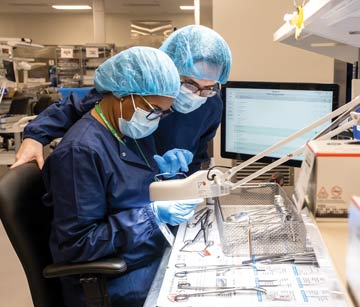Linda Spaulding, RN, CIC, is a fixer of sorts. When facilities are having a problem with their infection control practices, they call her in to figure out how to solve it. Based on her experience of observing surgical teams in ORs across the country, she believes treating instruments at the point of use continues to be an issue. "I think it's an area some facilities could improve upon, usually because of a lack of knowledge about the practice," she says.
Scrub techs must keep instruments clean between uses throughout surgery and moist when they're no longer needed for the procedure because dried blood coats surfaces or causes the joints of scissors to stick, factors that impact how well the tools work. Failing to treat tools at the point of use also allows bioburden to dry on surfaces and in crevices, making it harder for reprocessing techs to remove it in decontamination. That means the instruments won't get clean, and instruments that aren't properly cleaned can't be properly sterilized.
Point-of-use preparation removes gross soil and helps to prolong the life of instruments. "Substances such as blood and saline can break down the devices' protective finish," says Ms. Spaulding. "Soil and debris that dry on instruments become harder to remove from lumens and crevices, causing further damage to the instruments."
She suggests keeping soiled instruments moist by spraying them with an enzyme product, soaking them in an enzyme solution or water, or placing a moist towel over them until they're ready to be moved to the decontamination area.
"It's best to begin cleaning instruments within 15 minutes to one hour after a procedure," says Ms. Spaulding. "Prolonged delays can negatively affect the instrumentation. Over time, dried blood and bodily fluids can cause instruments to stain, pit, rust or become dull."
Surgical techs often set up back tables in a variety of ways based on the instrument sets needed for a case, the type of procedure being performed, as well as their training and personal preference. June Van Hoose, RN, CNOR, manager of quality and safety at Parkland Health & Hospital System in Dallas, realized this lack of uniformity ultimately impacted how well — and how efficiently — instruments were handled during and after procedures.
She established a standardized back table set-up to ensure instruments are organized the same way during every case. A tray of basic instruments — the tools needed most often during a case — is lined up along the table's left edge, an open workspace is established next to the tray and a basin of sterile water is positioned at the top of the workspace.
The standardized set-up decreases the number of times procedures need to be paused due to missing instruments, improves overall case efficiencies and lets the team focus more on workflow and patient care than keeping instruments organized.
It also ensures tools are accessible and easily cleaned, regardless of which staff member is working the case. That instruments are kept organized helps to ensure the tools are cared for properly before being sent to sterile processing.
Ms. Van Hoose believes the standardized set-up allows surgical techs to reorganize instruments more easily before placing them in closed carts for transport to the decontamination area. For example, they're able to quickly group sharps together so reprocessing techs know they should take extra care when pulling the instruments out for cleaning.
.svg?sfvrsn=be606e78_3)

.svg?sfvrsn=56b2f850_5)